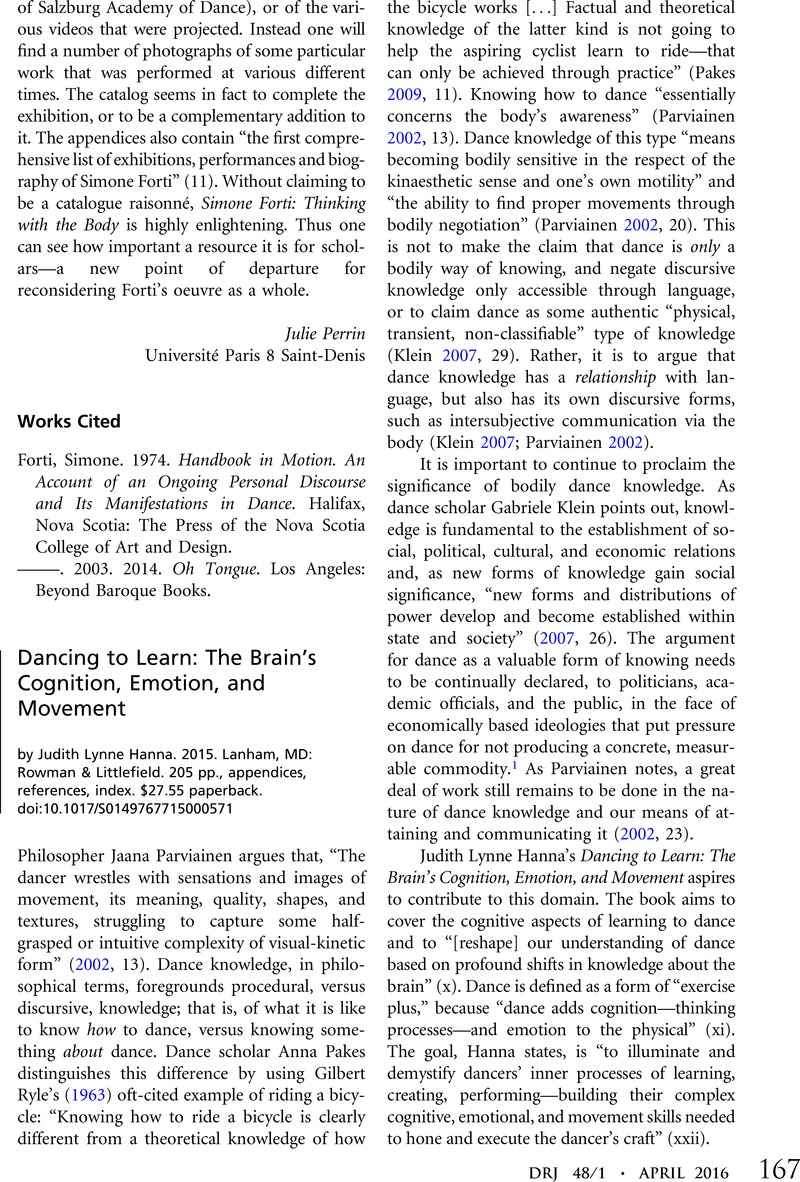No CrossRef data available.
Article contents
Dancing to Learn: The Brain's Cognition, Emotion, and Movement by Judith Lynne Hanna. 2015. Lanham, MD: Rowman & Littlefield. 205 pp., appendices, references, index. $27.55 paperback.
Review products
Dancing to Learn: The Brain's Cognition, Emotion, and Movement by Judith Lynne Hanna. 2015. Lanham, MD: Rowman & Littlefield. 205 pp., appendices, references, index. $27.55 paperback.
Published online by Cambridge University Press: 28 April 2016
Abstract
An abstract is not available for this content so a preview has been provided. Please use the Get access link above for information on how to access this content.

Information
- Type
- Book Reviews
- Information
- Copyright
- Copyright © Congress on Research in Dance 2016
References
Works Cited
Adshead-Lansdale, Janet, and Layson, June. 1994. Dance History: An Introduction, 2nd ed.London: Routledge.Google Scholar
Anderson, Michael. 2003. “Embodied Cognition: A Field Guide.” Artificial Intelligence 149: 91–130.CrossRefGoogle Scholar
Bull, Cynthia Jean Cohen. 2001. “Looking at Movement as Culture: Contact Improvisation to Disco.” In Moving History/Dancing Cultures: A Dance History Reader, edited by Dills, Ann and Albright, Ann Cooper, 404–413. Middletown, CT: Wesleyan University Press.Google Scholar
Carter, Alexandra, and O'Shea, Janet. 2010. The Routledge Dance Studies Reader, 2nd ed.London: Routledge.Google Scholar
Desmond, Jane C. 1997. Meaning in Motion: New Cultural Studies of Dance. Durham, NC: Duke University Press.Google Scholar
Foster, Susan L. 1986. Reading Dancing: Bodies and Subjects in Contemporary American Dance. Berkeley, CA: University of California Press.Google Scholar
Gibson, James J. 1979. The Ecological Approach to Visual Perception. London: Houghton Mifflin.Google Scholar
Klein, Gabriele. 2007. “Dance in a Knowledge Society.” In Knowledge in Motion: Perspectives of Artistic and Scientific Research in Dance, edited by Sabine Gehm, Pirkko Husemann, and Kathrina von Wilcke, 25–36. Bielefeld: German Federal Cultural Foundation.Google Scholar
Pakes, Anna. 2009. “Knowing Through Dance-Making: Choreography, Practical Knowledge and Practice-as-Research.” In Contemporary Choreography: a Critical Reader, edited by Butterworth, Jo and Wildschut, Liesbeth, 10–22. Abingdon, Oxon, UK: Routledge.Google Scholar
Parviainen, Jaana. 2002. “Bodily Knowledge: Epistemological Reflections on Dance.” Dance Research Journal 34: 1, 11–26.Google Scholar
STEM to STEAM. 2015. “What Is STEAM?” http://stemtosteam.org. Accessed October 10, 2015.Google Scholar
STEAM Education. 2015. “STEAM Education Home Page.” http://steamedu.com. Accessed October 10, 2015.Google Scholar
Thoms, Victoria. 2013. Martha Graham: Gender and the Haunting of a Dance Pioneer. Bristol, UK: Intellect.CrossRefGoogle Scholar
White, Harvey. 2010. “STEAM Mission Statement.” http://steam-notstem.com. Accessed October 10, 2015.Google Scholar

